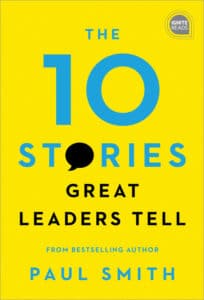As an experienced sales professional, no doubt you already tell a few stories. But how do you know you’re telling the right ones? Which stories are the most important that you should you be telling?
That’s a question Paul Smith has thought a lot about. He first answered it for salespeople in 2016 in his bestselling book, Sell with a Story, where he outlined 25 of the most common stories salespeople tell.
In his latest book, The 10 Stories Great Leaders Tell, Paul tackles that question for leaders in any discipline. And four of the ten are absolutely critical for salespeople.
After interviewing over 300 CEOs, leaders, and salespeople in 25 countries around the world about their use of storytelling in business, here’s his conclusion about the most important ten stories any leader needs to be able to tell at a moment’s notice:
1. Where we came from (our founding story)
2. Why we can’t stay here (a case-for-change story)
3. Where we’re going (a vision story)
4. How we’re going to get there (a strategy story)
5. What we believe (a corporate-values story)
6. Who we serve (a customer story)
7. What we do for our customers (a sales story)
8. How we’re different from our competitors (a marketing story)
9. Why I lead the way I do (a leadership-philosophy story)
10. Why you should want to work here (a recruiting story)
According to Paul, salespeople absolutely must master numbers 1, 6, 7, and 8.
You can find an example of each story in the book, along with some tips about how to find and craft your own. But to give you a flavor of what they’re like, here’s an example of #8:
#8: How We’re Different From Our Competitors
Sharad Madison is the CEO of the commercial cleaning company United Building Maintenance. When he’s is trying to explain how his company is different from his many competitors, he often tells the following story about what he does when he acquires a new client.
“When we take over a new contract, we typically have a thirty-day transition period. We take that time to go into the new building in the middle of the night to see how they’re cleaning it, to find out if they’re properly trained and have the right tools.
For example, we recently took over the contract for the Verizon building in New Jersey. That’s a 1.7-million-square-foot property across several buildings. So, we went in and found a guy vacuuming the carpet. It turns out, he was using the same kind of residential-quality vacuum cleaner you probably use at home. Now, those hallways are twelve feet wide and over half a mile long. Can you imagine trying to clean the whole property with the same machine you use at home? It could take a week, and it still wouldn’t be very clean. Plus, that vacuum will have to be replaced every few months.
When we took over, we ordered him a triple-wide, industrial-strength vacuum that’ll do the job in less than half the time and last forever.
Then we went to another floor and found someone shampooing those same carpets with a regular walk-behind shampooer. Again, that could take all night just to shampoo that one floor. We put him in a high-speed riding shampooer that could do the job in a fraction of the time, with much better results. Plus, it gets the guy off his feet. It’s safer for him and means fewer workman’s comp issues for me and the client.
Then we got to the offices and started looking at the top of the file cabinets. You could see half-moons swiped out on top of them. I know exactly why that happens. Those cabinets were five and a half feet tall and several of the people cleaning them were shorter than that. So, it’s not that they’re lazy. They just couldn’t reach high enough to clean all the way to the back.
We just gave them all these little plastic extension wands so they could reach all the way to the back with their dust cloths. Problem solved.”
Why that story works
Now, compare that story to how Sharad might explain his points of differentiation if he was using the more typical “features and benefits” type of selling language. It would sound something like this: “What makes us different is that we equip our cleaners with triple-wide, industrial-strength vacuum cleaners, high-speed riding shampooers, and extension wands for dusting.”
And that’s true. Those are the facts. But the story is far more compelling because with the story, buyers can see all of those pieces of equipment in use. They can see in their mind’s eye the guy going from the cheap vacuum cleaner to the triple-wide one. They can picture the guy riding around on the shampooer like the Zamboni driver on an ice skating rink. They can see, very clearly, someone easily cleaning all the way to the back of a tall, dusty cabinet with a plastic extension wand.
You don’t just need sales pitches. You need sales stories.
To learn more, check out The 10 Stories Great Leaders Tell. You can learn more about Paul at his website: www.leadwithastory.com.
As one of my loyal blog readers, I have an opportunity today for you to invest in your skills. Together, we can take today’s challenges and turn them into once in a lifetime opportunities. Consider this quote that I wrote in my new book, A Mind For Sales and say often:
When challenges arise we don’t rise to the occasion, we sink to the level of our training.
Are you ready? Watch the video above, and come be a part of the continued conversation as we all become masters in our fields and passions. My new program, The Sales Hunter University, is where you’ll find it all – unlimited personal growth, hands-on learning, quick tips, abundant resources, and an amazing community.
For more information and to join, click here!
Copyright 2021, Mark Hunter “The Sales Hunter” Sales Motivation Blog. Mark Hunter is the author of A Mind for Sales and High-Profit Prospecting: Powerful Strategies to Find the Best Leads and Drive Breakthrough Sales Results.






Great share Mark! Brene Brown says stories are facts with soul.